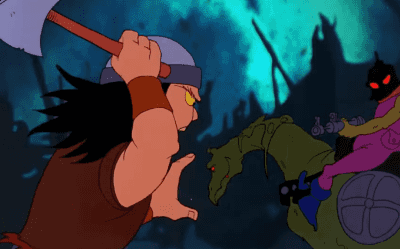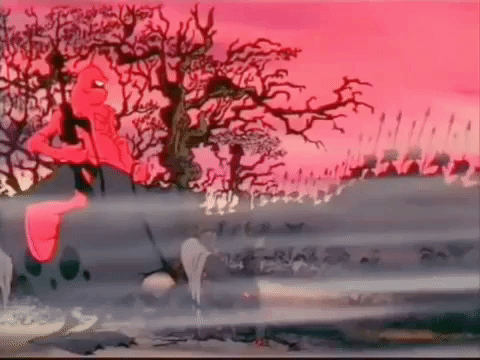originally posted at https://canmom.tumblr.com/post/657438...
Remember when we did two weeks anime, one week western? Haha… wow… imagine…
This week it’s time to once again pull our brains out of that one island’s insular media culture and check out somewhere else in the world. America. Which doesn’t have an insular media culture at all.

So. Ralph Bakshi… best known as one of the biggest names in creating such a category as ‘adult animation’ in America, thanks to his extremely horny early films like Fritz the Cat or TV shows like Spicy City. I wrote a bit about his career back on ‘live action x animation’ night…
So. Ralph Bakshi is another one of those animation auteurs with a distinctive style who you have to caveat a little before recommending lmao. With a background as a very young Jewish migrant in Brooklyn, Bakshi soon became very embedded in American counterculture. He got his first jobs in animation right at the bottom rung, as a ‘cel polisher’ responsible for cleaning dust from animation cels before photography, but worked his way up until he was directing films. Not content to work in the largely kid-targeted ecosystem, Bakshi was one of the people who went hard on pushing the ‘adult animation’ model, including its fumbling early experimentation with ‘haha, sex’. Most of his films (with exceptions like Wizards and his LotR) draw on the place he grew up, typically using very abstract archetypal characters; sex work is a major theme.
This video essay covers Bakshi’s work from a much more informed perspective than I can. My impression is, well, at his best Bakshi will take you into some fascinating psychic terrain; at his worst he leans entirely on shock value. At the time of Cool World, which is afaik his only time compositing animation with live action, Bakshi had made a few early films, like… sigh… “Coonskin” which was a dubious attempt to intervene positively against the medium’s history of racism, or, like Fritz the Cat, a film about a horny student cat which in reputation relied almost entirely on the shock value of talking about sex in an animated film.
However, as mentioned, he has a few films that really break from the ‘film about New York’ formula… namely, the wild sci-fantasy antifascist film Wizards in 1977, and the first film adaptation of Tolkien’s Lord of the Rings in 1978. Both films stand out as pretty unusual takes on the genre.

Let’s start with LotR, since it’s the one I’ve actually seen - if years ago, when writing about it for school. The film is notable for its extreme use of rotoscoping, i.e. tracing live action footage to produce animation.
As we’ll discuss in a couple weeks, rotoscoping has a long history in animation, dating back to the early days of Disney, but it also carries risks: if the animator simply copies the live footage without interpretation, the result tends to be extremely uncanny, lacking the complex shading information of live action and the readable shapes and poses of animation.
The early scenes of LotR do pretty well with the rotoscope - I remember a charming shot of Frodo and Sam wiggling their toes gaily at each other - as well as defining a number of shots that Jackson straight-up lifted (ahem, homaged) when he made his version of LotR… but a lot of shots do not actually rotoscope, but simply solarise the live action footage, essentially reducing it down to two tones. The result is… strange, but I think I might be better able to appreciate it now. The scenes of orcs marching on and chanting still sit somewhere in my memory after all!

If a kind of pastoralism vs industrialism conflict is already fairly close to the surface in LotR, it’s even more overt in Wizards. I mostly know of this film for its legendary final scene, but the overall thrust of the movie is the conflict between a good wizard Avatar and a bad wizard Blackwolf. Blackwolf, on losing a power struggle for control of the post-apocalyptic world, flees into space to use old Nazi propaganda reels to whip up a fascist army representing the forces of industrialism to take it back. The film concerns Avatar’s journey to try and infiltrate Blackwolf’s land and destroy his magic propaganda machine before he does Holocaust 2.
So you know, libidinal this, fascism that, it’s not trying to be subtle with its themes. Remains to be seen whether it handles them at all well! (My guess is, keep your psychic armour up). In any case it also seems to have a lot of fascinating environments presented in Bakshi’s typically dissonant mix of styles, with that inventive seventies sci-fi that hadn’t even taken off in Japan at the time. (This film narrowly predates films like Galaxy Express 999 and Lupin III: the Castle of Cagliostro).
Since my download is still going, I am also going to open tonight with some lesser known Bakshi - thanks to @mogsk we have the TV series Spicy City, a collection of cyberpunk noir vignettes which, coz it’s Bakshi, are probably going to strike an odd tone by the genre’s standards. I’ve seen only one episode of this so far, about the relationship between a detective girl and a sex worker who has been made into a cyborg by an evil scientist. That had a distinctive vibe, and the others promise to be similarly fascinating, so I’m going to try and sprinkle a bit more of that around our films tonight.
Animation Night 63 will begin in…. about 10-20 minutes, depending on how soon people manifest, over at twitch.tv/canmom! Hope to see you there!
Comments